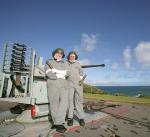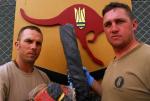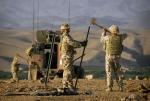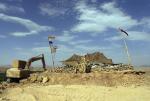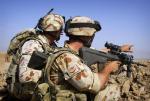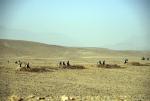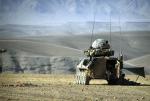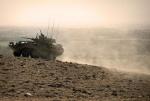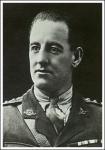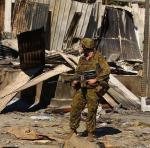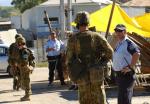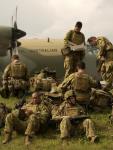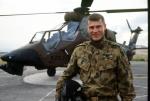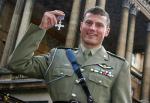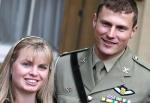-
Posts
1,411 -
Joined
-
Last visited
-
Days Won
1
Content Type
Profiles
Forums
Blogs
Gallery
Events
Store
Everything posted by Tiger-pie
-
From Navy News Volume 50, No. 14, August 09, 2007 Last blast for Bofors After 62 years? service to the RAN, the last three 40/60 Bofors guns were fired for the final time at West Head Gunnery Range at HMAS Cerberus on July 19. It took about an hour for staff to fire 432 round of ammunition from the AN4 Mod 2 guns. ?These weapons have provided outstanding service to the RAN. A very simple weapon to operate, the gun operated on a feed pull mechanism and was easy to maintain,? Weapon Training Officer LEUT Mal Bonehill said. The Fremantle Class patrol boats were the last in the RAN fleet to have operational 40/60 guns but, and with the decommissioning of the last two boats, HMAS Ipswich and Townsville in 2007, the only remaining firing gun mounts were retained at West Head Gunnery Range. One gun will be retained at West Head Gunnery Range; one will be donated to the HMAS Cerberus Maritime Museum; and the other one will be returned to stores. LEUT Bonehill spoke on the history of the guns. ?Prior to WWII the RN and RAN anti-aircraft weapon of choice was the 2 Pounder or ?Pom Pom? in a variety of mounting up to eight barrels for capital ships and some cruisers. The British Army adopted the Bofors 40/60 and it proved very successful an anti-aircraft weapon in the Africa campaign. ?With a breech capacity of eight rounds and taking four round clips, the gun could achieve a rate of fire of 120RPM and a range of 5000 yards. Ammunition retained a contact fuse and a tracer making it easy to aim. ?At one stage nearly all RAN ships carried some form of Bofors 40mm gun in their life. The Battle Class Destroyers Anzac and Tobruk retained up to 12 Bofor Guns, while the early Type 12 Destroyer Escorts were originally fitted a twin mounting in lieu of Seacat Missile System. ?The Daring Class Destroyers Vampire, Vendetta and Voyager mounted two twin and two single 40/60 guns. The carriers Sydney, Vengeance and Melbourne mounted up to eight single and eight twin guns, which included a twin gun being mounted forward of the island on the flight deck. ?Commissioned in the RAN in 1955, the fleet oiler HMAS Supply retained two twin mounts. Stalwart also mounted 40/60 mounts forward and aft, while Success and Tobruk had their mounts removed in the mid nineties. The old Attack Class Patrol Boats and Ton Class Sweepers mounted the old AN 2 Mod forward, while the survey ship HMAS Moresby mounted two single guns in 1965.?
-
Two bomb jockys from the Australian Explosive Ordnance Disposal display an IED found near the police outpost being built in the above shots. The device is on the left, and the black object on the right is the pressure plate. Crude but effective.
-
-
-
Within that cordon work is carried out. A specially-designed armoured excavator working at the police out-post work site. These machines provide soldiers with the same balistic protection as their armoured vehicles.
-
A LMG crew in a gunpit provide an inner cordon of security, behind them is a police outpost being constructed by engineers.
-
In one of the pits two troopers keep an eye out for any movement in front of their position. Note that in absense of a cloth helmet cover, the soldier at left has painted his helmet.
-
Despite the modern perception that mechanised infantry don't dig in, they seek shelter in gun pits to protect themselves from mortar and rocket attack.
-
-
In the area of the above mentioned fire-fight, an ASLAV moves into position to provide a security cordon.
-
Shot of a Blackhawk during anti-terror training in the CBD, with the Sydney Tower in the background.
-

Australian cloth patches
Tiger-pie replied to Bob Lyons's topic in Great Britain: Militaria: Badges, Uniforms & Equipment
Gay... We have a similar thing in the Navy, and I'm guessing the RAAF do too. I left my instructor billet just before it became a requirement to wear a brassard in, get this, tri-service colours to identify us on a Naval base. I would have had to wear a badge similar to that on my shirt. A brassard is fine if you wear fatigues, or a shirt that has epalettes, but the twit who introduced it forgot that for six months of the year sailors wear short sleeve shirts with nothing to fix a brassard to. Regards; Johnsy -
TP, But didn`t an Aussie win two VC`s in WW2? Shhhh, the bloody Kiwis might hear you. They would go mad in Un-Zud if they heard you say that., he was a New Zealander. What was the name of the AIF guy who won the VC at Gallipoli, taking the trench and killing 7 Turks single handley? Lance Corporal A lbert Jacka. Goin` off topic again, what the ribbon on your avatar? Check this thread out. http://gmic.co.uk/index.php?showtopic=18524 Regards; Johnsy
-
Only three people ever got a second VC, so no, the chances are slim though not impossible. There are probably many acts of valour that went without reward. Two Aussies came close, that was Albert Jacka VC, MC and Bar. C.E.W. Bean wrote: "Everyone who knows the facts, knows that Jacka earned the Victoria Cross three times'. And after the war "It is not for an historian to say but in the case of Albert Jacka something clearly went wrong. Albert Jacka should have been the most decorated soldier in the AIF." According to Jacka's biographer, Dr. Ian Grant: "Ironically, although Jacka clearly went on to perform greater deeds of valour, his superiors were determined ... [to] deny... him further recognition." This was due to his outspoken nature and his "unforgivable offence" of criticising his superior officers, hence breaching the "code of freemasonry" which protected senior officers of the regular army. As a result, Elliot (Major General) said: "General Birdwood ordered that Jacka's report should be expunged from the records of the AIF and Jacka himself was thence onward systematically ignored both in regard to decorations and promotions." Jacka finished the war at the rank of Captain. And "Mad Harry" Murray. VC, CMG, DSO and Bar, DCM, MiD (4), CdeG. He was known admiringly throughout the AIF as 'Mad Harry' because of his fearlessness in patrols in No-Mans-Land and his ferocity in hand-to-hand fighting. Murray was far from 'mad'. He planned attacks and trained his men with great care and always sought to avoid casualties. He was recommended for a second VC at Stormy Trench, north-east of Gueudecourt, France on 4/5 February 1917. Captain Murray led his company to the assault and quickly captured an enemy position. Very heavy fighting followed, and three times counter-attacks were beaten back owing to this officer's wonderful work. During the night the company suffered heavy casualties and on one occasion gave ground, but Captain Murray saved the situation, encouraging his men, leading bayonet charges and carrying the wounded to places of safety. The recommendation for the VC noted that "his Company would follow him anywhere and die for him to a man". He finished the war as an Lt. Col. and served in a training capacity during WW2. He remains Australia's most decorated soldier. There was some ill feeling back in Australia after the war that because these two men had risen through the ranks rather than been commisioned officers with the right connections, as well as the fact that they were "Colonials", they were denied a second VC. Both were outstanding combat officers who cared about their men, and reducing casualities through sound tactical doctrine i.e. fighting smarter. Albert Jacka put forward a report on the use of troops supporting armour that was later described as "brilliant" (and may have been used illicitly by General John Monash in preparation for the successful Battle of Hamel), but due to his earlier indiscretions he was given no credit for his efforts.
-
Errrh... Well I can only speculate on this one, but as it essentially has the same criteria for qualification, I would imagine that the Victoria Cross for Australia would take higher precedence as the rules currently state. It would however make more sense that the original award would be retained with the name and date of when first act of valour took place regardless of which country awarded it. The bar would then be awarded by the respective government. He definately would not be able to wear two VC ribands, there is no Gallantry or Bravery medal in the British or Commonwealth system that can be awarded twice or more as individually worn medals. I can't confirm that the post-nominials can or can't be used by Major Watkins. In the Army News (paper) though he is never refered to as Watkins DFC. Regards; Johnsy
-
The order of wear is correct, he can wear the DFC ahead of his Australian awards, but if he was to receive any Australian Gallantry or Bravery award wether it is higher or lower than the DFC then that medal would be worn in front of the Imperial DFC. It is basically splitting the medal precedence into two levels, if that makes sense. Any lower grade of medal would have to come after our own medals. What needs to be taken into account here is that they are not really a "foreign" award as such, Imperial awards are still represented of our table of wear. Indeed, when I was in Canberra I worked with a Commander (Navy pilot) who was still wearing his DSC, so there is still a need for this "duplicity". Watkins isn't the only Australian in this position, an Naval officer I know has the MVO. Again this is exactly the same situation as Watkins, if he was to be awarded any Australian medal of a similar class, then the MVO would be placed behind that medal, but not behind all other Australian awards of a lower grade. Watkins award is the first of its type since the Vietnam war. Regards; Johnsy
-
I hope this is true, it would finally put all the rumours to rest and be a focal point for those surviving families. Though I'm not sure about their method! Regards; Johnsy The 66-year search for the wreck of HMAS Sydney is believed to be over. The ship, in which 645 Australians died, is believed to have been found by a group of West Australians using a grappling hook and a camera last weekend. The Sydney sank after a battle with German raider, Kormoran, on November 19, 1941, Fairfax newspapers said. Video film of the find shows tangled wreckage over large, much longer than any other ship known to have sunk nearby. The search team believe the video, which shows decking bolts, radio aerials, steam tubes and signs of massive damage show the wreck is the Sydney. The shipwreck is near Cape Inscription on the northern end of Dirk Hartog Island. It is in about 150 metres of water.
-
-
#5 A soldier from 1 Section, 10 Platoon, D Company peers down the main road of Honiara. The effects of the rioting can be clearly seen.
-
-
-
-
Operation Anode - Solomons Islands is a stabilisation operation to restore law and order and political stability. The ARA has been helping the Australian Federal and S.I. Police quell anti-government violence. Honiara, the capital, was virtually reduced to ashes. Picture #1: Soldiers wait to be airlifted to S.I.
-
AN AUSTRALIAN army officer is to be awarded Britain's Distinguished Flying Cross for his bravery in taking control of a British helicopter while under heavy fire in Iraq. Major Scott Watkins, of Baulkham Hills, in Sydney, was on secondment to the famed British Black Watch regiment south of Baghdad last November when the helicopter he was co-piloting came under machine-gun fire from the ground. At least three rounds struck the Lynx helicopter, one of the bullets ripping into the cockpit and hitting the pilot, Captain Keith Reesby. Watkins, a captain at the time, took the controls and flew the helicopter through heavy fire for six minutes to get back to base. Later he modestly dismissed his swift action as just doing his duty, but the Black Watch commander said he saved the life of his crew. Watkins, 34, said his helicopter flew into the path of bullets aimed at a Puma helicopter that was flying ahead of them. "I thought the bullets had come through the floor," he said. "What had actually happened was that we were banking hard to the right and they had come through the window. My gunner saw two guys in a trench firing up from 100 to 200 metres away. "It was extraordinarily unlucky. We have Kevlar seats and Kevlar protection at the sides. There is a five-centimetre gap between and that is what one of the bullets went through." Two more bullets damaged instruments, making flying hard as Watkins weaved and dodged rocket-propelled grenades fired from the ground. "We fly low to avoid giving people on the ground too much time to prepare an attack," he said. "But I'm afraid there are so many people on the ground with guns that something like this will happen." The wounded Black Watch pilot was a close friend of Watkins. A bullet passed through Captain Reesby's arm into his chest, narrowly missing his heart, but the helicopter's swift return to base saved him. The Chief of the Army, Lieutenant-General Peter Leahy, yesterday congratulated Watkins on the award, which will be presented soon. Watkins had proved himself to be a cool and courageous pilot, General Leahy said. The Royal Air Force award is the third-highest British military award for bravery. It is rare for it to be given to an army officer. Watkins' wife, Karen, was four months pregnant at the time. She was at a British army base in Germany with their 2?-year-old daughter, Brienna, as her husband was in the last six months of a two-year secondment to the Black Watch. Watkins returned to Sydney with his family in January, but could not be reached yesterday as he was on exercise.



